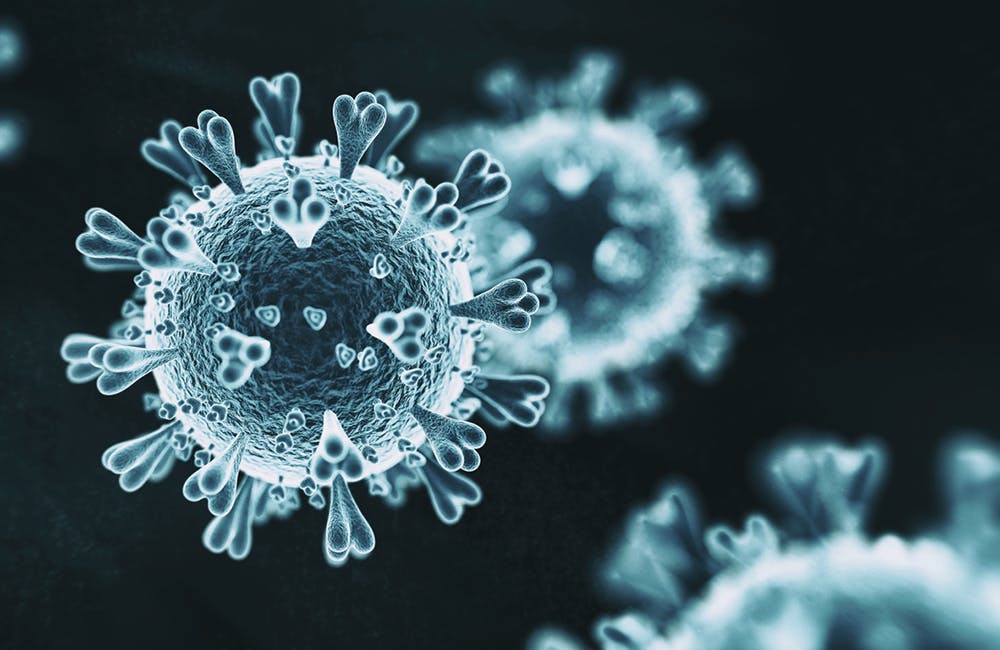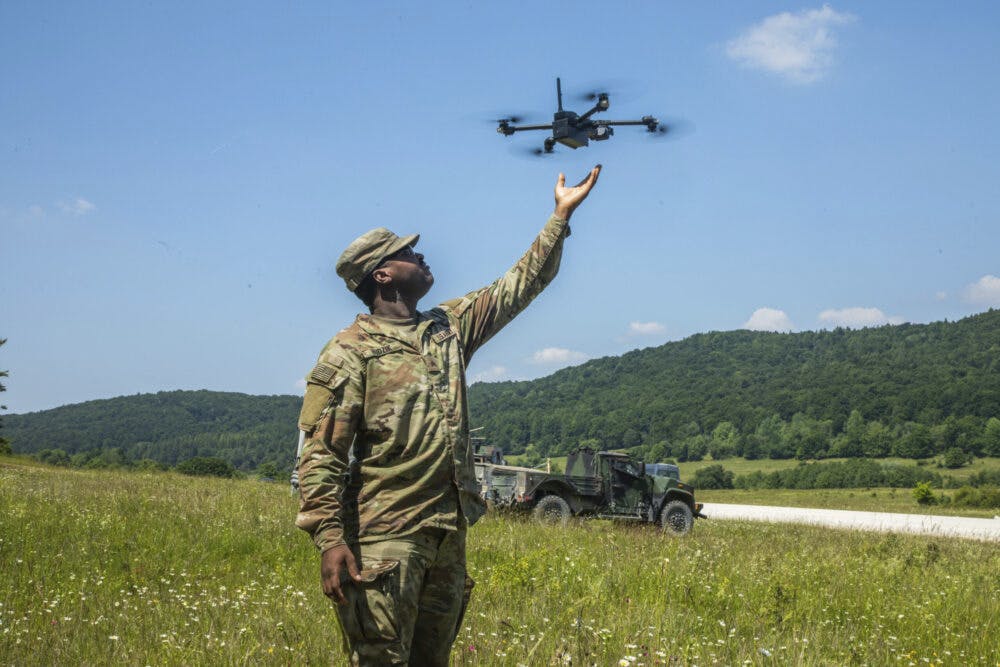NIH Launches Private-Public Coalition for COVID-19 Therapies, Vaccines
The group will consolidate data and resources to research and develop COVID-19 pharmaceutical solutions.

The National Institutes of Health’s formation of a public-private partnership group will aim to consolidate its research and development efforts for therapeutic interventions and vaccines for COVID-19.
The group, known as Accelerating COVID-19 Therapeutic Interventions and Vaccines (ACTIV), includes NIH, Biomedical Advanced Research and Development Authority, Food and Drug Administration, Centers for Disease Control and Prevention, European Medicines Agency, as well as 16 private-sector companies.
Members of each of the participating organizations discussed forming a partnership to consolidate otherwise disparate efforts to make pharmaceutical solutions to COVID-19 more efficient, NIH Director Dr. Francis Collins said in a press conference Friday. Collins said that NIH looked to preexisting partnerships, such as Accelerating Medicines Partnership, to rapidly launch the group within a few weeks.
Participating organizations met April 3 to create a strategy for ACTIV, which resulted in a four “fast-track focus areas.”
Standardizing and Sharing Preclinical Evaluation Methods
ACTIV’s first task area is to create the network infrastructure to enable the participating groups to share methods and evaluation methods with a centralized process and repository of information.
These steps will involve “extending access to high-throughput screening facilities, especially in biosafety level-three laboratories, with a goal of testing all compounds that have been in human clinical trials to identify the potential to apply these compounds to COVID-19,” NIH said.
The group also agreed to increase access to validated animal models and to enhance comparison of approaches to identify informative assays in these early stages.
Collins said sharing and standardizing these early evaluation methods and materials are important because officials and experts have started to identify known candidates that may be optimal for therapeutics if their compounds could be repurposed properly for COVID-19 treatment.
“We wanted to be sure that there are known candidate optimal therapeutics that were developed for something else,” Collins said. “It might turn out to have just the right properties for COVID-19, what we call repurposing of a previous compound, and that meant having a preclinical group that would survey all the options, develop the appropriate ways of testing all those compounds to see if they might have been good using various updates or animal models, and bringing anything forward quickly.”
Accelerate Clinical Evaluation of Therapeutic Candidates
While ACTIV works on the first task in its pipeline, the group is also establishing a steering committee of experts who will set criteria for and rank possible COVID-19 therapeutic candidates that industry partners submit for evaluation.
ACTIV has currently identified over 100 candidates that have already been considered for clinical therapeutics, Collins said. The steering committee will examine these candidates to create a short list that the group will move quickly into clinical trials to see whether they work appropriately for quelling COVID-19 symptoms.
“That’s the more appropriate way to approach this, as opposed to having a very large number of gathered trials, some of which may be focused on compounds that actually aren’t that compelling in terms of the reason to test them and may not be as sufficient in study design to give you a clear answer,” Collis said of the second task’s approach.
Throughout this second-step process, ACTIV will also aim to develop an inventory of all potential candidates, as well as their different mechanisms of action and acceptable safety profiles, and the group will design, launch and open sharing master protocols with agreed upon endpoints, sampling and analysis for evaluating the candidates.
Maximize Clinical Trial Capacity
In its third area of work, ACTIV will look at all clinical trial capacities that it has in both private and public sectors to identify patients that the group can approach for randomized trials.
Collins highlighted that NIH has an extensive list of clinical trial networks, generally devoted to studies of specific diseases, that it will leverage — both in infrastructure and expertise — and compile them with private-sector clinical trial networks to maximize the reach of potential patients to test trial therapeutics and vaccinations.
In doing this, ACTIV will establish a coordination mechanism across its networks to expedite trials, track incidence across sites and project future capacity, NIH said.
Advance Vaccine Development
NIH has identified over 40 vaccine development programs currently underway, but those efforts have not connected with each other or with the FDA process as tightly as NIH would like to see, Collins said.
To work in a streamlined fashion in COVID-19 vaccine research and development, NIH said that ACTIV will create a collaborative framework to share insights into natural immunity an vaccine candidate-induced immune response by:
- Mapping epitopes and developing assays
- Establishing protocols for sampling and immunological analyses and reagents
- Colleting clinical data on immunological responses and endpoints to enable meta-analysis of correlates of protection
- Engaging with regulators on surrogate endpoints for clinical evaluation
Next Steps
As ACTIV’s participating organizations work toward the group’s newfound goals, the Foundation for the National Institutes of Health Senior Vice President of Research Partnership David Wholley will help manage ACTIV after acting as the main project manager for AMP.
ACTIV is currently mostly immersed in tackling the first two items in its four-part strategy, particularly in developing a pathway to get promising compounds and launching the clinical trials. Collins said that he asked the ACTIV group to start yielding trial results and identify which compounds are most effective in combating COVID-19 by this June or July.
Although Collins said that the formation of the group doesn’t likely change the 12- to 18-month development period for a potential vaccine, he said that the consolidated data and resources will help facilitate the national effort toward a COVID-19 vaccine and therapies in the meantime.
Collins and Wholley emphasized that data — and potentially data-driven technologies like artificial intelligence — will be essential in consolidating and expediting ACTIV’s work.
“NIH has invested increasingly more abundantly in AI, in machine learning, deep learning approaches to lots of things, including certainly vaccine development,” Collins said. “We’re in a phase of trying to move really fast with information that is pretty much needing to be collected into inventories and then acted upon. … We certainly have a concern about data and how to make sure that data is captured and shared. That is an intention of this effort — to get the data off to be accessible to everybody.”
“It’s about finding the right drugs that might work, finding the patients to get them tested in and the right preclinical testing to make sure that they’re safe and effective to use on those patients, and finding the sites and the places where they can be most effectively tested and the right trial design,” Wholley added.
Collins said that he will continue to provide public comment on ACTIV’s progress and updates as the group works to meet the goals outlined in its strategy.
This is a carousel with manually rotating slides. Use Next and Previous buttons to navigate or jump to a slide with the slide dots
-

DHA CDAO Spearheads Master Data Catalog to Boost Transparency
Jesus Caban plans to boost DHA's data maturity through a new master data catalog, governance frameworks and inventory of tech tools.
5m read -

IHS Prepares to Deploy PATH EHR at Pilot Sites in 2026
IHS targets PATH EHR pilot in 2026, emphasizing governance, collaboration and interoperability as key pillars of the modernization strategy.
4m read -

Trump Orders Spark Government-Wide Acquisition Overhaul
As Trump pushes for a faster, simpler procurement system, agencies are leveraging AI and adapting strategies to meet new requirements.
5m read -

IRS Makes Direct File Code Public as Lawmakers Debate Program’s Fate
The agency sees the Direct File source code as beneficial to government digital services despite what happens with it in proposed budgets.
5m read -

Inside Oak Ridge National Lab’s Pioneer Approach to AI
Energy Department’s Oak Ridge National Lab transforms AI vulnerabilities into strategic opportunities for national defense.
22m listen -

A Look at Federal Zero Trust Transformation
Recent developments from CISA and DOD show how government is advancing zero trust quickly.
20m read -

Modernization Strategies to Enable Energy Innovation
Lawrence Berkeley National Lab and Maximus experts explore the modernization strategies driving digital transformation and operational resilience within the energy sector.
33m watch -

DOI Must Modernize Energy to Win AI Race, Secretary Says
Doug Burgum links AI innovation to energy reform as DOI advances digital infrastructure and wildfire response under Trump’s tech agenda.
2m read -

Army Combines Commands to Propel Innovation Under New Transformation Plan
Lt. Gen. Miles Brown outlines a new transformation strategy after the AFC–TRADOC merger to integrate new technologies within 18 months.
4m read -

NIST to Release New AI Cybersecurity Guidance as Federal Use Expands
NIST plans to release AI cybersecurity guidance within the year to support safe adoption as federal agencies expand use cases.
4m read -

Federal Zero Trust Forum
The Federal Zero Trust Forum brings together key technology leaders from across government to explore practical strategies and share lessons for advancing zero trust architecture.
Ritz Pentagon City | 1250 S Hayes St, Arlington, VA 22202 -

CIA Adds Fourth Pillar to AI Strategy, CAIO Says
Lakshmi Raman says the new pillar marks a strategic shift toward embedding AI more deeply into the CIA’s day-to-day mission execution.
3m read
















